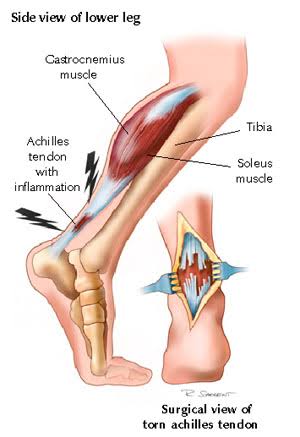What is Achilles Tendon Rupture?
Tendon is a band of tissues that connect the muscle to the bone. The Achilles tendon is such a tendon that runs down behind the lower leg and connects the calf muscle to the heel bone. The Achilles tendon facilitates walking as it helps to raise the heel off the ground. Achilles tendon rupture is a complete or partial tear that occurs due to the stretching of the tendon beyond its stretch limits.
Symptoms OF Achilles Tendon Rupture
Complete rupture of Achilles tendon shows the following symptoms:
- Sharp pain felt during rupture
- Immediate pain is present but gradually decreases
- A loud crack or pop sound during rupture
- Giving way like sensation in the posterior heel after pushing off
- Gap felt on palpating the tendon
- Swelling present behind the heel
- Inability to raise the heel
- Impaired gait
- Positive Thompson Test
Arthritic conditions like rheumatoid and lupus can also affect other organs of the body with a variety of symptoms like:
- Muscle aches and pains
- Swelling and tenderness
- Feeling of tiredness
- Inability to use the hand
- Inability to walk
- Difficulty in moving the joint
- Poor sleep
Pathology: Achilles tendon pathology is different based on anatomic location, histopathology, or generic names. The pathology can be divided into abnormalities within the mid-portion of the tendon or in the structures surrounding the tendon, or a cluster of abnormalities that can occur at the tendon insertion. The rupture can occur with or without these underlying tendon pathologies.
Causes of Achilles Tendon Rupture
Many factors contribute to the cause of arthritis-like:
- Wear-and-tear associated with day-to-day weight-bearing
- Trauma or injury to the joint
- Prior infection
- Prior surgery
- Diabetes
- Autoimmune processes
- Deposition of calcium pyrophosphate dihydrate crystals of monosodium urate
Diagnosis Of Achilles Tendon Rupture
Physical Examination: During the physical examination, the examiner looks for redness and swelling in and around the joint, range of motion of the joints. Depending on the type of arthritis, the examiner also looks for rashes, checks the eyes and throat, and records the temperature.
Laboratory tests: Laboratory tests are done to rule out other diseases that have similar symptoms as those experienced by a condition like Fibromyalgia or RA (rheumatoid arthritis).
Magnetic resonance imaging (MRI): Magnetic resonance imaging (MRI) is done to study the soft tissues in the diagnosis of Fibromyalgia.
X-ray: X-rays are used to study the bones for the damage that can be the cause, for symptoms such as joint pain or stiffness.
Treatment Of Achilles Tendon Rupture
Medications: NSAIDs, pain killers, corticosteroids, analgesics, etc.
Note: Medication should not be taken without the doctor’s prescription.
Surgery: Surgery is recommended for a patient with severe arthritis. Surgery is applicable when conservative treatment is not effective for the patient.
Fusion: In this surgery, two or more bones are permanently fused, this process immobilizes a joint and reduces pain caused by the movement.
Joint Replacement: Damaged, an arthritic joint is replaced with an artificial joint. Joint replacement surgery preserves joint function and movement.
Physiotherapy Treatment Of Achilles Tendon Rupture
Thermotherapy: Heat therapy has an analgesic effect causing relief from muscle spasms and increasing the elasticity of periarticular structures. Heat therapy can be used before exercise to gain maximum benefit for 10-20 minutes once or twice a day.
Cryotherapy: Ice therapy can be used to decrease inflammation and pain.Ice is usually applied in active joints, it can be applied as ice, nitrogen spray, and cryotherapy.
Ultrasound therapy: Therapeutic ultrasound helps to stimulate the healing process by increasing blood flow and decreasing pain and inflammation.
Transcutaneous electrical stimulations (TENS): Transcutaneous electrical nerve stimulation therapy is used to increase strength after the daily application of 15 minutes of TENS. It also helps in reducing synovial fluid and inflammatory exudate in acute arthritis and thus provides pain relief.
Laser therapy: Laser therapy is highly effective for pain relief, it causes a natural healing response from the body because it increases circulation and can break up calcified deposits in the joints.
Interferential Therapy: Interferential therapy is used to treat muscle strains, spasms, joint damage, and edema. Interferential therapy can provide relief from chronic pain, inflammation, and swelling.
Kinesio Taping: Kinesio taping helps decrease pain and increase the function of the joints.
Manual Therapy: Manual or hands-on therapy helps manage arthritis symptoms. Two of the most common treatments include manual manipulation or mobilization and massage therapy.
Hydrotherapy: Hydrotherapy can help to relax the muscles and ease the pain in the joints. Water supports the weight, which helps to relieve pain and increase the range of movement of the joints. Water can be used to provide resistance to moving joints by pushing the arms and legs against the water, this can also help improve muscle strength.
Exercises: Exercises include passive range of motion, active range of motion, stretching, and strengthening exercises to increase range of motion, flexibility, strength, and endurance.
Patient Education
The patient is advised to do physical activity that is simple and effective, as it can reduce pain, improve function, and also reduce the risk of developing other chronic diseases. The patient is advised to perform low-impact activities that are easy on the joints like walking, bicycling, and swimming so that there is a low risk of injury. Also losing excess weight and staying at a healthy weight is particularly important for people with arthritis.


